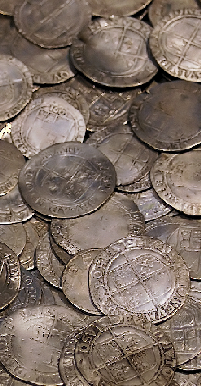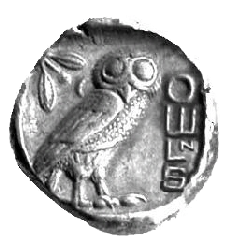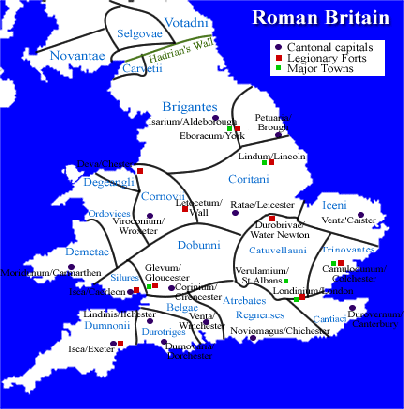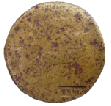
● Next Meeting Status:
Cancelled



● Host Society for the
BANS 2011 Congress
held in Southport


Where to next?

Coinage In Roman Britain
The Coinage Of Britain During The Roman Occupation
Peter R Thompson
“In 55BC Julius Caesar invaded Britain to be met by primitive savages painted with woad. They gave him a hard time but eventually Roman discipline prevailed and Roman rule was established. The Romans then went around building roads and dropping coins until the Saxons arrived.”
Although historians and numismatists will recognise a number of inaccuracies in this summary, it nevertheless seems to be the popular understanding of Britain’s three and a half centuries as part of the Roman empire. The purpose of this paper is to discuss what really happened in a little more detail, and to look particularly at the coins.

Whether Caesar ever intended a full-
Caesar did have a hard time, but Roman discipline and sophistication did prevail. What could well have been a rout of the Roman forces in 55BC was turned into an orderly withdrawal, and they returned the next year. They found in Britain a tribal civilisation sufficiently well organised to raise, however briefly, a single army presumably under single leadership, at the time and in the place where it was required – an Iron Age civilisation with a developed agriculture, an established priesthood, and the beginnings of a monetary economy. In short, a people far from the painted savages of historical myth.

Caesar’s campaigns achieved several important objectives. The stronghold of Cassivellaunus,
leader of the warlike and anti-
Caesar did not, though, find the rich treasures he had hoped for. Most of his agreements lapsed when he left; the tributes were not paid for long, and Cassivellaunus was still at large.
The Britons may have considered Caesar’s withdrawal to have been something of a victory. The Senate, though, considered that, with military victory over Cassivellaunus, Britain had been conquered and only had to be officially taken over at some convenient date to make it a full Roman province.
For the next hundred years or so, relations between Britain and Rome remained on
this basis. There is evidence that trade between Rome and the pro-
However, the Catuvellauni continued their expansion throughout southern Britain at the expense of neighbouring tribes. Among others, this affected both the Trinovantes, and the Atrebates, another tribe with whom Rome developed treaty relations. By c. AD40 the Atrebatic kingdom was so reduced in size that its king, Verica, arrived in Rome as a supplicant requesting some sort of action on his behalf.
The Emperor at the time was Claudius, and he may well have been looking for just such an opportunity to improve his lagging popularity. In any case, the expanding and hostile Catuvellauni had to be checked. Although Roman policy since the time of Augustus had been against expanding the empire, Claudius nevertheless decided to risk his credibility with an invasion of Britain. He succeeded brilliantly, or, at least, his generals succeeded for him.

The Romans landed at Richborough in AD43 and, after a short delay so that Claudius himself could be present, took possession of Britain as a province of the Roman empire, later that year.
An arch was built at Rome to celebrate the triumph, and coins were struck to mark the occasion, which were the first Roman coins to refer to Britain. Like many other coins, issued from time to time up to the third century, which bore Britannia’s name, these coins depicting the triumphal arch were for circulation in Rome and the empire as a whole. Their function was not to provide a local currency for Britain, but to give wider publicity to Claudius’ successes. Other provinces were similarly named on the coins, on relevant occasions, so that coins naming Africa, Asia, Dacia, and so on, would have been at least as common in Roman Britain as those naming Britannia.
Roman rule of their new province was at first limited to the southeast. By AD47 the area south and east of the Fosse Way, which runs from Axminster to Lincoln, was firmly under Roman control, but this was probably not a deliberately chosen frontier. It marked the geographical border of the lowlands and, although the Fosse Way was fortified, there were forts to the north and west of it, too. The conquest continued.
In the early days, the Romans created client rulers outside their immediate area of occupation. Prasutagus, king of the Iceni in East Anglia, was one such, and soon Cartimandua, queen of the Brigantes to the north, was also recruited. The Romans were careful to appoint rulers rather than to create permanent client states. A client king or queen was not necessarily followed by a natural heir or, indeed, by anyone if it then suited Rome to take over.

These client kingdoms may have retained coining rights, but other local coinages would definitely have ceased. The Brigantes had almost certainly never produced coins of their own, but the Iceni may have continued coining until the famous revolt against Roman rule in AD60 under their queen Boudicca.
Usually known today as Boadicea, her statue adorns London’s Westminster Bridge. She was the widow of Prasutagus, and the Romans did not intend that she continue her husband’s ‘client’ status. She is rumoured to be buried under what is now Platform 10 at London's Kings Cross Station.
Full Roman rule took some time to reach the west of England and parts of Wales. Its
extension northwards suffered several setbacks over the years, before the northern
boundary of the empire was more or less settled with the building of Hadrian’s Wall
in the second century, from the Tyne to the Solway Firth. Once again, this was probably
not seen by the Romans as a fixed frontier. For several years an Antonine Wall, named
after Antoninus Pius, emperor AD138-
The northern frontier area of Britain, though, was always a military region. The northern limit of Roman civilian culture was the river Tees.

Administrators and Accountants
The arrival of the Roman legions and the administration of the province brought with
it an immediate requirement for large amounts of money in coin. The Romans, naturally,
introduced into Britain the coins which were in use in Rome at the time. The gold
aureus was used for large payments, but not much for day-
These relationships are known today as the Augustan monetary system, because the
settled tariffs for the various denominations were arrived at under Augustus, the
first emperor, 27BC-
The mere presence of the Romans acted as a spur to the development of a monetary economy in Britain. Long distance transport was a problem, so that food, fodder, livestock, building materials and so on were all purchased locally. Around the military settlements, traders would set themselves up to provide the goods and services required by the soldiers and civil servants. The Romans in Britain were practically all government servants, either military or civil, and had to be paid. Taxes and dues had to be levied to pay for the whole set up.

Although pay for the Roman legionary was one denarius per day, a fairly sophisticated system of keeping back money for his eventual discharge, and deductions for food and equipment, left him (perhaps wisely) with much less actual spending power, and most of the payments to the troops appear to have been in aes. Obviously, most of the smaller transactions between the Romans and the local traders would also have been in aes, and it was this requirement for huge quantities of large, heavy coins which presented the authorities with their first major problem concerning the provision of coinage in Britain.
All Roman aes at this time was struck at Rome, which was a long way from Britain. Very few ships attempted the stormy passage west of the Pillars of Hercules, so the heavy bags of coin would have to be carted with strong military escort the length of Europe, and taken by sea across the Channel. Little wonder that the military paymasters were soon short of coin.
The solution to the problem seems to have been the striking of large numbers of ‘unofficial’ asses of Claudius, copying the official as, with Minerva on the reverse. Just who produced these copies is uncertain, but the fact that they are sometimes found with genuine coins in hoards shows that the better copies, at least, were officially accepted. Numismatic opinion varies, but it seems likely that these better copies were produced officially as a temporary measure to supply the local shortage, while the poorer examples were produced by local entrepreneurs who seized the opportunity to, literally, make a bit of money.
There was a long tradition during the Republican and Imperatorial periods, of Roman commanders in the field being permitted to strike coins, when required on a campaign far from home, so the striking of a temporary coinage in Britain by the local administration should not be considered unlikely.

Another measure was the countermarking of Claudian and earlier aes, which seems to have taken place all along the northern frontiers of the empire, including Britain. The purpose of these countermarks – usually a few letters such as AVG, PROB, etc – applied to the obverse of worn coins is not known, but, like the Claudian copies, their presence in hoards shows that countermarked aes were officially accepted. The marks may have been applied by officials, to confirm the continued validity or revaluation of old and inferior coins, when the supply of new coins to the frontier areas was very difficult.
At about this time, c. AD64, Imperial aes began to be struck at Lugdunum. The reason
for this is obscure, but Lugdunum was certainly closer to the geographical centre
of the western empire – while the east was still mainly using locally-
During the early empire there were other occasions when a shortage of aes in Britain
may have led to locally-

Until the fourth century the governor of a Roman province (appointed by the Emperor and acting on his behalf) was in overall charge of military and civil affairs. Financial affairs were in the hands of the procurator, who collected taxes, paid the army, and supervised imperial property.
Administrative changes in the fourth century meant that Britain, like other provinces of the Empire, henceforth had a civil governor (Vicarius) and a duke (Dux Britanniarum in the case of Britain) in charge of the military.
Initially Britain was governed from Colchester, but the administration soon moved to London. Late in the second century or early in the third the province was divided into Britannia Superior, governed from London, and Britannia Inferior, governed from York. From the beginning of the fourth century Britannia Superior and Inferior were both subdivided, and the four resulting provinces were known as Britannia Prima (the southwest), Maxima Caesarencis (the southeast including London), Flavia Caesarencis (the midlands and Lincoln), and Britannia Secunda (the north including York). From AD369 a fifth province, Valentia, appears somewhere in the north of Britain but its extent and exact location are uncertain

By the end of the first century AD, the Romans were able to begin a period of consolidation in Britain. Wooden forts were replaced with those of stone, stone villas began to appear in the country, and public buildings were erected in the cities.
During the second and third centuries, most cities in Britain built defences, and
by the fourth century almost all urban settlements were walled. This may indicate
some sort of military presence in most towns at the time, and also that the administration
seems to have been worried more about raiding incursions than an all-
Relative to its size and population, Britain had an extremely large garrison, with three permanent legionary bases. Legion II Augusta was quartered at Caerleon, Legion VI Victrix at York, and Legion XX Valeria Victrix (probably named for its victory over Boudicca) at Chester. There were also large numbers of smaller auxiliary units in the province, which came from all over the empire. Auxiliary units were probably recruited locally in Britain from around the AD80s, but the legions themselves were manned exclusively by Roman citizens. As time went on, some Britons were accorded the privilege of Roman citizenship, and local recruitment to the legions themselves probably began in the mid second century. It wasn’t until around AD214 that the emperor Caracalla granted full citizenship to all free inhabitants of the empire.

The high quality of the Roman gold and silver coinage began to decline under Nero, who reduced the weights of the coins, and also the fineness of the silver, in AD64. Before this reduction, perhaps half of the Roman silver circulating in Britain was old republican denarii. After it, the republican element in hoards gradually reduces.
A major debasement of the silver coinage took place towards the end of the second century. Around AD214 or 215, a larger silver coin was introduced by Caracalla (whose real name was Marcus Aurelius Antoninus) which has become known in modern times as the antoninianus after the emperor. It was almost certainly intended as a double denarius – the emperor is always shown on these coins wearing a radiate crown, just as the dupondius (two asses) often uses the same device. It is because of this radiate crown that the antoninianii are sometimes referred to as ‘radiates.’ Their silver content and weight were significantly less than that of two denarii, although the denarius itself remained the dominant silver coin until the AD230s.
During the third century, the antoninianus was steadily reduced in fineness and weight until by the AD260s it was often little better than an aes coin. These debasements of the third century reflect, to some extent, the state of the empire itself.
Emperors from all corners of the empire came and went with remarkable rapidity, although nearly all of them (even Marius who is said to have lasted only two or three days in AD268) managed to strike coins. Some of these rulers were only able to claim rule of part of the empire.

It was in this climate that the phenomenon known as the ‘Gallic Empire’ arose. Under the successive emperors Postumus, Victorinus, Tetricus I and Tetricus II, an area roughly corresponding to Britain, Gaul and Spain, effectively seceded from the central empire between c. AD260 and 273. During this time, when Gallienus, Claudius II and then Aurelian, were the legitimate emperors in Rome, Britain was cut off from the main empire.
The Gallic emperors struck huge quantities of radiates, some denarii and a little gold at their mints, probably Trier and Cologne, and for the period of their usurpation these were the coins that entered Britain. At around this time, a shortage of official coin in Britain and Gaul led to the local production of large numbers of imitation antoninianii; these unofficial issues are known today as ‘barbarous radiates.’
After AD273, there was probably some attempt to suppress the coinage of the late Gallic usurpers, and this could have created further shortages. The use of barbarous radiates in Britain probably continued until c. AD286. They copy the coins of the central as well as the Gallic rulers, and some are so ridiculously small that it is difficult to imagine them all circulating at par.

The Gallic Empire was followed in AD287 by a British usurpation under Carausius,
AD287-
The shortage of coin was remedied by the opening of the first identifiable Roman mint in Britain. It is debatable if the mint of a usurper can be termed ‘official’ but the product of the London mint was very similar to the mints of the central empire.
In his yearning for recognition, Carausius sometimes used the style AVGGG on these coins, the extra ‘G’s signifying his ‘colleagues’ Diocletian and Maximianus who were now ruling in Rome and Byzantium. Carausius’ London mint was soon supplemented by a second mint, probably established at Colchester.
It was during the usurpation by Carausius and Allectus that the emperor Diocletian,
AD284-

Diocletian’s Reform and the Common Currency
Another of Diocletian’s reforms was an overhaul of the coinage, which probably took
place over several years, and which marked the end of the old Augustan monetary system.
The aureus had reduced considerably in weight during the third century, but was increased
to 1/60th of a pound around AD290. Already, by AD301, this coin was known to the
Romans as a solidus, but numismatists today apply the new term to the lightweight
coin of 1/72nd of a pound first introduced by Constantine I in AD309. There had been
no regular supply of silver coins since the debasement of the antoninianus, but Diocletian
re-
Diocletian continued to strike the radiate antoninianus, but now with no pretence
that it was anything other than aes. There was also a small laureate aes coin, probably
in the same 1:2 relationship to the radiate as the denarius had been to the antoninianus.
The main subsidiary coin, though, was now a large silver-
Coins of all mints circulated throughout the empire and, as hoards show, mixed fairly quickly. Obviously, local mints supplied the majority of new coinage in any one province, and the London mint, which had been set up by Carausius, was kept in use by the central emperors until c. AD325.

Other western mints such as Trier and Lugdunum also supplied a large part of the circulating medium of Britain, particularly after the closure of the London mint, but coins of more distant mints such as Siscia, Cyzicus, Nicomedia and Alexandria circulated quite happily alongside them.
Diocletian’s reforms also brought an end to the independent coinages of the eastern empire. By and large the same types were in issue at all mints at the same time thus creating a truly common European currency, with an apparent ease which must be the envy of many modern Eurocrats.
The relationship that Diocletian’s coins bore to each other is not known with certainty today, nor are the values at which they circulated. The contemporary names of the aes coins are also mysteries, but it is possible that the currency system, by 301, was something like this:
Aes laureate = 2 denarii
Aes radiate (post reform) = 4 denarii
Silver washed aes (follis) = 20 denarii
Argenteus = 100 denarii
Aureus (solidus) = 1500 denarii
It must be stressed, though, that this is guesswork, and other systems have been suggested based on an aes laureate of one denarius.

The fourth century was a period of continuous change to the coinage. The smaller aes coins disappeared within a few years, and the follis was reduced in size quite rapidly, until by 337 it was only around 15mm in diameter (known as AE3 today.) This smaller coin was probably known to the Romans as a centenionalis. Larger billon coins, possibly known as ‘maiorina,’ were introduced in 348 with a reverse legend of FEL TEMP REPARATIO, and these may have contained a nominal amount of silver until c. 371.
A shortage of aes in Britain in the 350s led to the same local remedy as had produced the third century barbarous radiates, and huge numbers of copies of the FEL TEMP REPARATIO coins, some very small, were produced in Britain and Gaul. An interesting development during this rash of imitations was the overstriking of earlier coin types by the FEL TEMP forgers, perhaps because of an official recoinage of earlier types. This overstriking seems to be peculiar to Britain.
After Adrianople, the battle in which emperor Valens was killed in 378, the eastern and western empires began to diverge. The west generally declined in importance, stability and security, while the east prospered and eventually became the Byzantine Empire. The unified coinage also began to diverge from c. 380 after which eastern issues of aes are rarely found in Britain.
In spite of inflation and obvious problems with the supply of an adequate subsidiary coinage, gold and silver became more plentiful as the fourth century progressed, and the coins maintained constant purity.

The lapse of the western empire into virtual anarchy led inexorably to its demise. The real decline of Roman control in Britain probably began about the middle of the fourth century with barbarian incursions coming from what are now Scotland, Ireland, Germany and Holland. These incursions were raids for personal enrichment, rather than attempts at invasion, but by the mid 360s barbarian attacks on the north western provinces of the empire became more concerted – a new and worrying trend for the Romans.
A military defeat of the Romans in Britain in AD367 by several barbarian tribes led
to a general breakdown of law and order, large scale desertions from the Roman army,
and unchecked plundering of the province. The subsequent re-
After this, the last thirty years of the fourth century may well have been a peaceful
and prosperous period for the province, although it included the usurpation of Magnus
Maximus, AD383-

When, in the early fifth century, the capital of the Gallic prefecture, through which
Britain was administered, was moved south from Trier to Arelate, this must have led
to a growing feeling of isolation in Britain and, once again, to political unrest.
The move south was due to barbarian incursions into Gaul, and followed the removal
of the Western seat of government from Milan to Ravenna. It was probably the uncertainties
caused by this which led to usurpations of power in Britain by influential Romans
during the early fifth century. The first two attempts to seize power at this time,
by a ‘Marcus’ and a ‘Gratian’ in AD406-
Constantine’s seizure of power was almost certainly a genuine attempt to secure the province of Britain against the Alans, Vandals and Suevi, who were spilling into Gaul, and against whom the central authorities were taking little action other than the removal of their regional capital southwards. His choice of name, and the fact that, like Carausius before him, he used the title AVGGG (and sometimes AAAVGGGG) on his coins to indicate equality with the central emperors, is an indication of the importance that he attached to himself and his mission, but he does not seem to have been popular in Britain, and was only tolerated by the western emperor Honorius for as long as was necessary.
To oppose the Gallic incursions, Constantine III took his Romano-

In fact Honorius was not strong enough, or interested enough, to mount a cross-
The amount of gold in circulation increased in Britain, as in the rest of the empire,
in the later fourth century, and the province was very well supplied with silver.
Silver struck after AD402 is scarce in British finds, however, and the official import
of aes coins into Britain seems to have ceased soon after AD400, as no post-
From the usurpation of Constantine III in AD407, no coins of the central empire would have been officially sent to Britain except, perhaps, after Honorius temporarily recognised Constantine in AD409. He did, though, strike his own coins in the Gallic mints – gold, silver, and a little aes. These were probably not struck in very large quantities, as they are all rare today, but some are found in Britain.
The end of official Roman administration in Britain in AD409 was sudden, but the
people who remained in the ex-
It was once thought that many of the smaller imitations of Roman coins found in Britain, of the barbarous radiate and FEL TEMP types, were struck for local use during the first half of the fifth century. While it is possible that some of them were, site finds which are securely dated show that even the smallest of these imitations were current at the same time as the originals. In any case, why copy coins that were no longer current?
Although the prime need for a coinage had disappeared with the Roman army, there must still have been a need for currency of some sort for a number of years. Probably the aes in circulation, which are often found very worn today, were sufficient for small transactions, and a few aes coins were still imported until at least AD435.

Late fourth century siliquae found in Britain, sometimes in large hoards, are often clipped quite severely. This phenomenon is not known from elsewhere within the empire, but it does occur in areas outside it. It would therefore seem that these clipped silver coins belong, in Britain, to the period after the Roman withdrawal. The clipping of these earlier coins perhaps brought them into line with the weight of fifth century Gallic coins.
Some citizens no doubt still owned quantities of solidi for wealth storage, but widespread coin use in Britain probably ceased by c. AD430. A sixth century site, Castle Dore, is completely coinless, and the next coinage to appear in Britain was that of the Germanic settlers in the seventh century. But that is another story.
The last known appeal by Britons to Rome was in AD443, according to the Anglo Saxon
Chronicle. It was unsuccessful, but the Britons who fought the battle of Mons Badonicus,
c. AD500, probably still thought they were defending a basically Romano-

The following map shows the locations of the principal civil and military features of Roman Britain.

Click to go directly to your chosen chapter
The Beginning
Soldiers
Administrators & Accountants
Consolidation
The Third Century Revolts
Diocletian’s Reforms and
the Common Currency
The Beginning of the End
The Final Days
For Reference -
of Roman Britain
Hover your cursor to
see greater detail

Obverse & Reverse of a silver denarius issued for Julius Caesar from an unknown mint believed to have been in Africa
Republican denarii circulated in Britain well into Imperial times



Obverse & Reverse of a sestertius issued for the Emperor Claudius
Claudius’ coinage was the first Roman money to enter Britain in quantity


Obverse & Reverse of a silver unit of the Iceni tribe, sometimes attributed to Queen Boudicca

Orichalcum Dupondius, issued by the Emperor Caligula in the name of his father Germanicus.
Countermarked NCAPR

Detail of the NCAPR Countermark
Nero Caesar Augustus PRobavit?


An Orichalcum Sestertius of the Emperor Antoninus Pius, the reverse showing a seated figure of Britannia. Similar designs appeared on dupondii and asses possibly struck at a field mint in Britain


Debased billon Antoninianus of the ephemeral Emperor Marius, said to have been a blacksmith, killed with a sword of his own manufacture after a reign of three days. Not really very likely!


Debased billon Antoninianus of the Emperor Postumus thought to have marked the opening of the second mint
in the Gallic Empire, possibly at Cologne

Barbarous Radiate
Celtic copy of circulating Roman Antoniniani, produced both in mainland Europe and in Britain



Antoninianus issued by Carausius who maintained a breakaway state in Britain and northern Gaul . In his quest for recognition some very rare coins showed Carausius as the colleague of Diocletian and Maximianus, the legitimate Emperors


Silver-
London Mint, indicated by the mintmark PLN in the exergue
Silver-
PROVIDENTIAE AVGG, Cyzicus Mint




Clipped silver Siliqua of the Emperor Honorius, from the mint at Milan, indicated by the mintmark MDPS in the exergue


Silver Siliqua of the Emperor Constantine III, from the mint at Trier, indicated by the mintmark TRMS in the exergue
